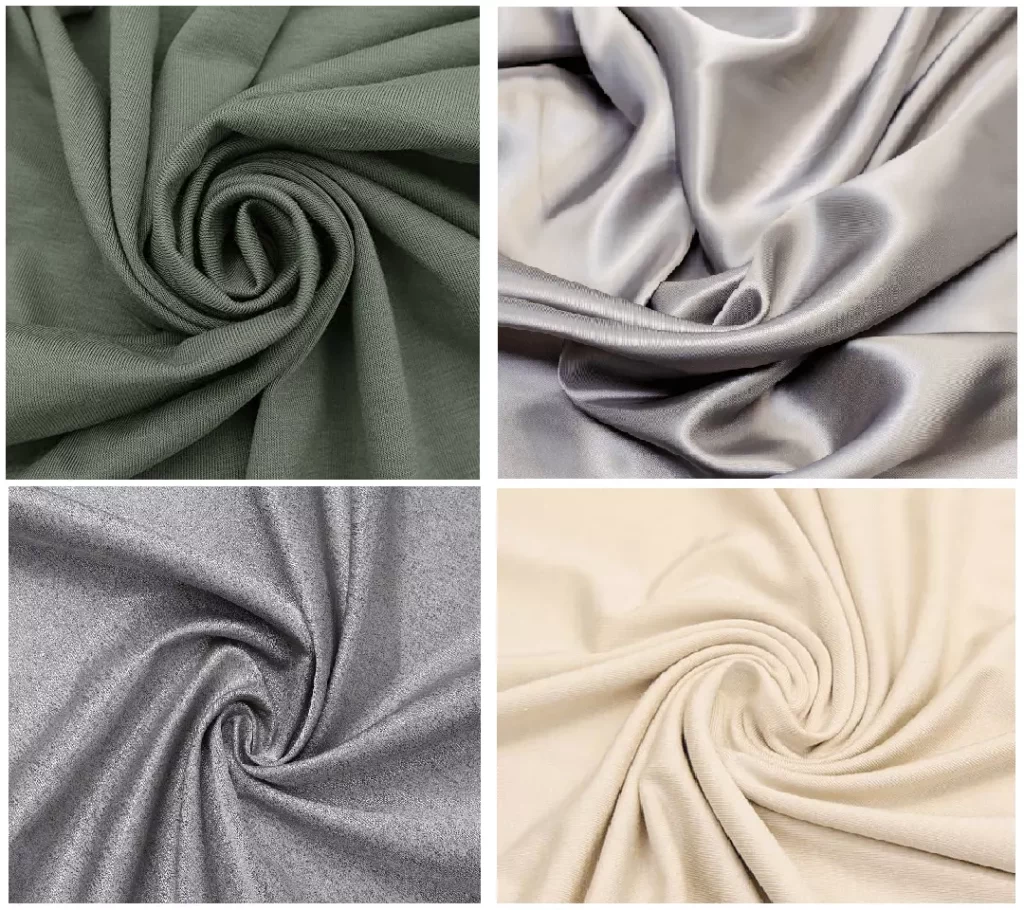In addition to rayon viscose, rayon HWM is also one of the fabrics made from the cellulose of wood pulp. Rayon HWM is also known as modal fabric. So what is modal fabric? Let us learn about this fabric and see how they are different from viscose fabric.

Modal fabric is a semi-synthetic fabric made from cellulose obtained mainly from the wood pulp of oak or eucalyptus trees. In addition, the modal is also mixed with cotton and spandex to increase its durability. Modal fabric is also known as HWM rayon fabric. Modal fabric is softer and more airy than viscose, so the price is also much higher.
In addition to wood pulp, the fabric also has to go through a process of contact with complex chemicals to ensure perfectness. That is why the modal fabric is a semi-synthetic fabric.
In 1950, this fabric is first produced in Japan. The fabric has properties similar to rayon viscose, but the process of forming modal reduces waste significantly, so the modal fabric is more and more popular.
Besides, the modal fabric is much lighter than viscose, and the breathability is also very high, so it has gradually become a competitor to viscose. In addition to viscose fabric, the modal fabric is also starting to become a fabric that goes against lyocell.
Both are similar fabrics, but the manufacturing process or advantages and disadvantages of the two types are quite different.
Manufacturing Process of Modal Fabric
This is a version of rayon viscose fabric, but the modal fabric has a different manufacturing process than viscose:
Extraction of cellulose
First, the oak or eucalyptus trees need to harvest. These are the two main types of wood used to make modal fabrics. Wood after being harvested will be divided into small chips. These crumbs will be purified to form cellulose.
Create the press plate
Use the roller to squeeze out all the water inside the wood chips so that they are formed into plywood boards. These plywood panels are further soaked in caustic soda, also known as NaOH solution. For modal fabric, the concentration of NaOH is much lower than that of viscose fabric, so the waste after the fabric is finished will also be much less.
Generate Sodium cellulose xanthate
The pressed plates after soaking in caustic soda solution will be divided into small pieces. This debris will continue to be directly soaked in carbon disulfide to form sodium cellulose xanthate.
Spinning yarn
To make the final compound, sodium cellulose xanthate is then exposed to caustic soda again. This compound will be put into a rotating machine to press into strands.
Finished Product
The yarns pressed by the machine will be soaked in sulfuric acid, and then spun to make the fabric stronger. Finally, they will be taken away to be woven into fabric.
Advantages of Modal Fabric
High breathability
The fabric is suitable for the production of sportswear and summer wear because of its very high breathability which makes the wearer feel comfortable and comfortable.
Good Elasticity
Modal fabric is not only cool but also has an excellent elasticity. With such good elasticity, the fabric is very suitable for sewing products that match the shape.
Soft
Whether you touch or look at it, you will feel the softness that this fabric brings. With a flawless surface like this, mattress manufacturers use a lot in creating quality products for people to have a good night’s sleep.
High Absorbency
Compared to cotton, the modal fabric is twice as absorbent. With this advantage, consumers will not feel squeamish or uncomfortable on hot sunny days.
High Durability
Although the fabric is elastic or has a soft surface, it does not cause rapid sagging or damage. The fabric is tightly woven so the durability of the fabric is also ideal. If you know how to preserve, products such as clothes can also be used for several years.
No Shrinkage
Unlike other rayons, modal fabrics do not shrink when exposed to water or through long-term use. This helps to prolong the life of the products.
Environmentally Friendly
Although the process emits pollutants to the environment, the amount of waste is not much and the products made from fabrics are biodegradable.
Wrinkle –free
Another good advantage of the fabric is that it is wrinkle-free; the fabric is not wrinkled after each wash, saving a lot of time for consumers.
Disadvantages of Modal Fabric
Allergic
Although derived from plants, to perfect modal fabrics, they have to go through a lot of different chemical reactions. Therefore, some people will be allergic to these substances when using them.
Depleted Forests
Many places harvest trees for timber but do not plant or take care of them, making resources widely exploited and exhausted.
Application of Modal Fabric
Garment production
With outstanding features such as high breathability, good sweat absorption, and good elasticity the fabric is used a lot to produce clothes for sports such as dancing, athletics, and gymnastics. Tool. In addition, the fabric is also used to sew products such as:
- Men’s and women’s t-shirts
- Trousers
- Dress
- Sleepwear
- Shawls
Production of Beddings
Many manufacturers in the bedding industry use modal fabrics a lot. With its coolness as well as the soft surface, it is very suitable to create an ideal resting space for people. Not only that, but cleaning is also easier when the fabric dries very quickly and it is difficult to produce a musty smell. Such favorable conditions will be a stepping stone to help your bedroom space become much cooler and airy.
Tips for Using Modal Fabric
Washing water temperature
For fabrics with good softness and elasticity, you should use cold water to wash them. Hot water can cause the fabric to shrink, losing its inherent properties.
Use a washing bag
For machine washing, you should use a laundry bag to ensure the best protection for your clothes. In addition, it prevents soap powder from sticking to the fabric when washing.
Oxygen bleach
Using bleach causes clothes to wear out faster. Therefore, when it is necessary to use bleach to clean products from modal fabrics. You should use bleach that contains oxygen.
Natural drying
Modal fabrics dry very quickly, so you should not interfere too much in the drying process for the fabric. Just drying in a well-ventilated place is enough to dry the fabric. If the time is too short, you can use the dryer, but only on low heat.
Light washing
It is essential when washing that you should only use your hands to gently rub, and avoid strong rubbing that ruffles the surface of the fabric.
Modal fabric is one of the most preferred fabrics by many consumers to use on hot sunny days. The lightness and sophistication that modal material brings will be a key advantage for it to develop more in the future.

